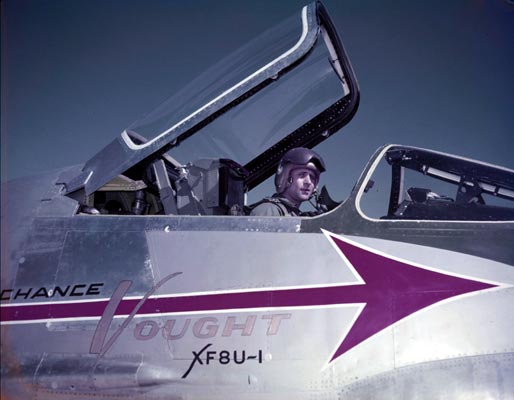
![]() 25 March 1955: Chance Vought Aircraft Corporation experimental test pilot John William Konrad took the first prototype XF8U-1 Crusader, Bu. No. 138899, for its first flight at Edwards Air Force Base in the high desert of Southern California.
25 March 1955: Chance Vought Aircraft Corporation experimental test pilot John William Konrad took the first prototype XF8U-1 Crusader, Bu. No. 138899, for its first flight at Edwards Air Force Base in the high desert of Southern California.
The new fighter had been transported from the factory at Dallas, Texas, aboard a Douglas C-124C Globemaster II, on 3 March 1955. It was reassembled and all systems were checked. Taxi tests began on 14 March.
During the first flight on 25 March, the Crusader went supersonic in level flight. It was able to maintain supersonic speeds (not only for short periods in a dive) and was the first fighter aircraft to exceed 1,000 miles per hour in level flight (1,609 kilometers per hour).
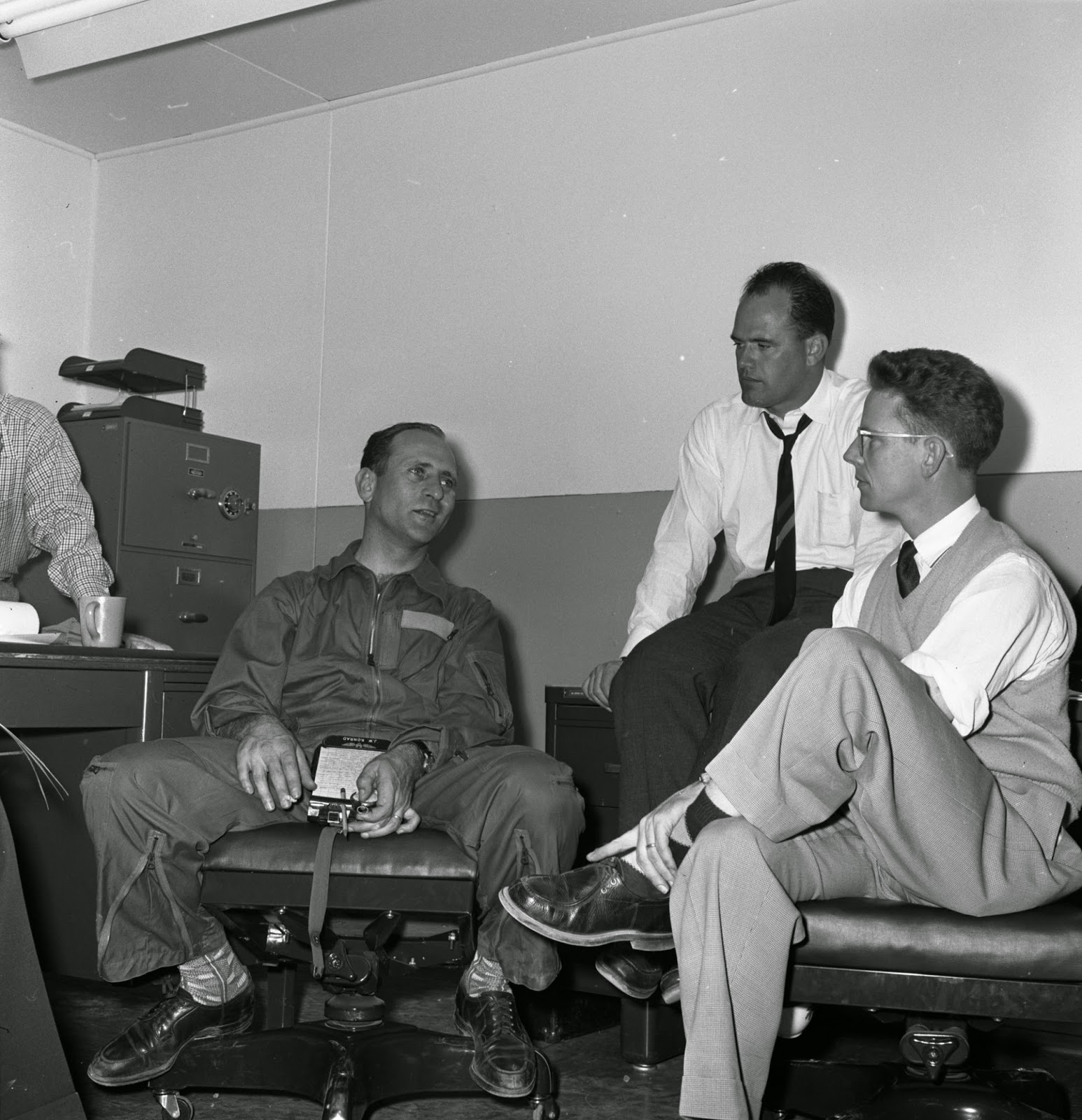
The F8U Crusader has a unique variable-incidence wing which can be raised to increase the angle of attack. This created more lift at low speeds for takeoff and landing aboard aircraft carriers, but allows the fuselage to remain fairly level for better forward visibility.
The test program went so well that the first production airplane, F8U-1 Crusader Bu. No. 140444, made its first flight just over six months after the prototype’s.
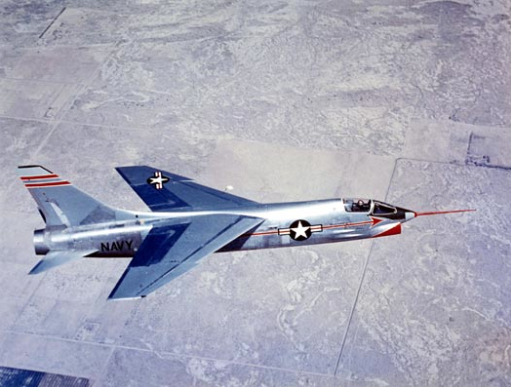
The Chance Vought F8U-1 was nearly identical to the prototype XF8U-1. It was a single-place, single-engine swept-wing fighter designed to operate from the United States Navy’s aircraft carriers. The F8U-1 was 54 feet, 2.75 inches (16.529 meters) long with a wingspan of 35 feet, 8 inches (10.871 meters) and height of 15 feet, 9.1 inches (4.803 meters). With wings folded, the airplane’s width was reduced to 22 feet, 6 inches (6.858 meters).
The Crusader’s wing angle of incidence was adjustable in flight. It had a total area of 375 square feet (34.8 square meters). The leading edges were swept aft to 47°, and the outer panels had a 1 foot, 0.7 inch “dog tooth.” The wings had 5° anhedral, while the horizontal stabilator had 5° 25′ dihedral. The stabilator’s leading edges were swept 50°.
Its empty weight was 15,513 pounds (7,037 kilograms) and maximum takeoff weight was 27,500 pounds (12,474 kilograms).
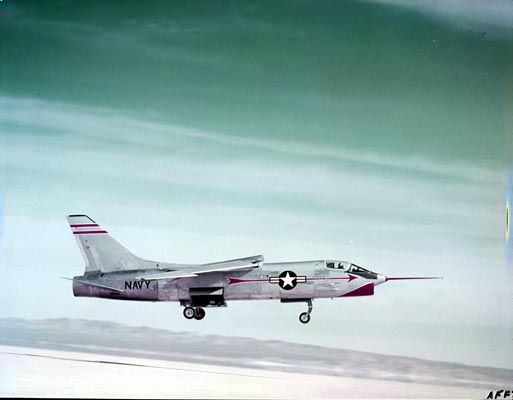
 Early production aircraft were powered by a Pratt & Whitney J57-P-4 engine. This was a two-spool, axial-flow turbojet engine with a 16-stage compressor and 3-stage turbine. The J57-P-4 had a normal power rating of 8,700 pounds of thrust (38.70 kilonewtons); military power, 10,200 pounds (45.37 kilonewtons), and a maximum rating of 16,000 pounds (71.17 kilonewtons) with afterburner. The engine was 20 feet, 10 inches (6.350 meters) long and 3 feet, 5 inches (1.041 meters) in diameter.
Early production aircraft were powered by a Pratt & Whitney J57-P-4 engine. This was a two-spool, axial-flow turbojet engine with a 16-stage compressor and 3-stage turbine. The J57-P-4 had a normal power rating of 8,700 pounds of thrust (38.70 kilonewtons); military power, 10,200 pounds (45.37 kilonewtons), and a maximum rating of 16,000 pounds (71.17 kilonewtons) with afterburner. The engine was 20 feet, 10 inches (6.350 meters) long and 3 feet, 5 inches (1.041 meters) in diameter.
The F8U-1 had a cruising speed of 494 knots (569 miles per hour/915 kilometers per hour). Its maximum speed was 637 knots (733 miles per hour/1,180 kilometers per hour) at Sea Level—0.95 Mach—and 860 knots (990 miles per hour/1,180 kilometers per hour) at 35,000 feet (10,668 meters)—Mach 1.50. It had a service ceiling of 42,300 feet (12,893 meters) and combat range of 1,280 nautical miles miles (1,473 statute miles/2,371 kilometers).
The F8U Crusader was known as “The Last of the Gunfighters” because it was the last American fighter aircraft to be designed with guns as the primary armament. It carried four Colt Mark 12 20-mm autocannon with 500 rounds of ammunition. It could also carry two AIM-9 Sidewinder infrared-homing air-to-air missiles.
Because of a high accident rate, the Crusader has also been called “The Ensign Killer.”
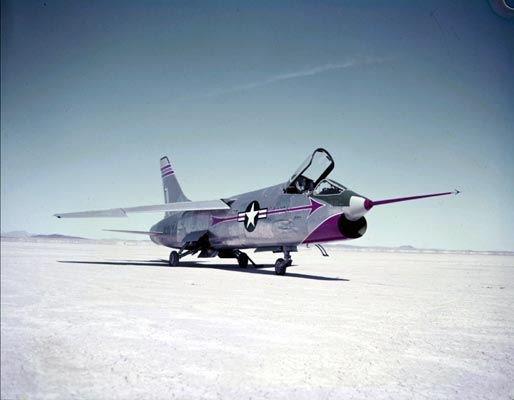
The Vought F8U Crusader was in production from 1955 through 1964 with a total of 1,261 built in both fighter and photo reconnaissance versions.
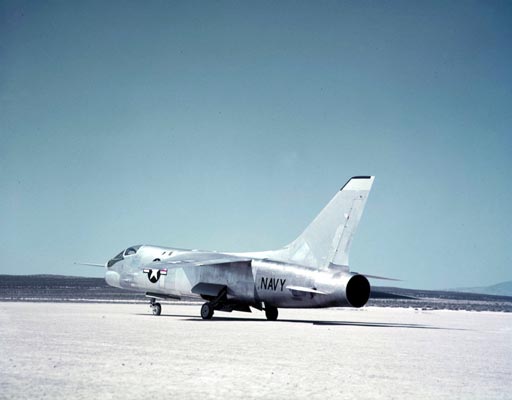
During five years of testing, Bu. No. 138899 made 508 flights. It was donated to the Smithsonian Institution in 1960. The restored prototype is now at The Museum of Flight, Seattle, Washington.
According to information recently discovered by The Museum of Flight, fighter pilot, test pilot and future astronaut John Herschel Glenn, Jr., made his first flight in a Crusader when he flew Bu. No. 138899 on 4 May 1956. According to Glenn’s logbook, he made two flights in the prototype on that date, totaling 2 hours of flight time. Many thanks to Mike Martinez, a docent for the museum for providing this information.
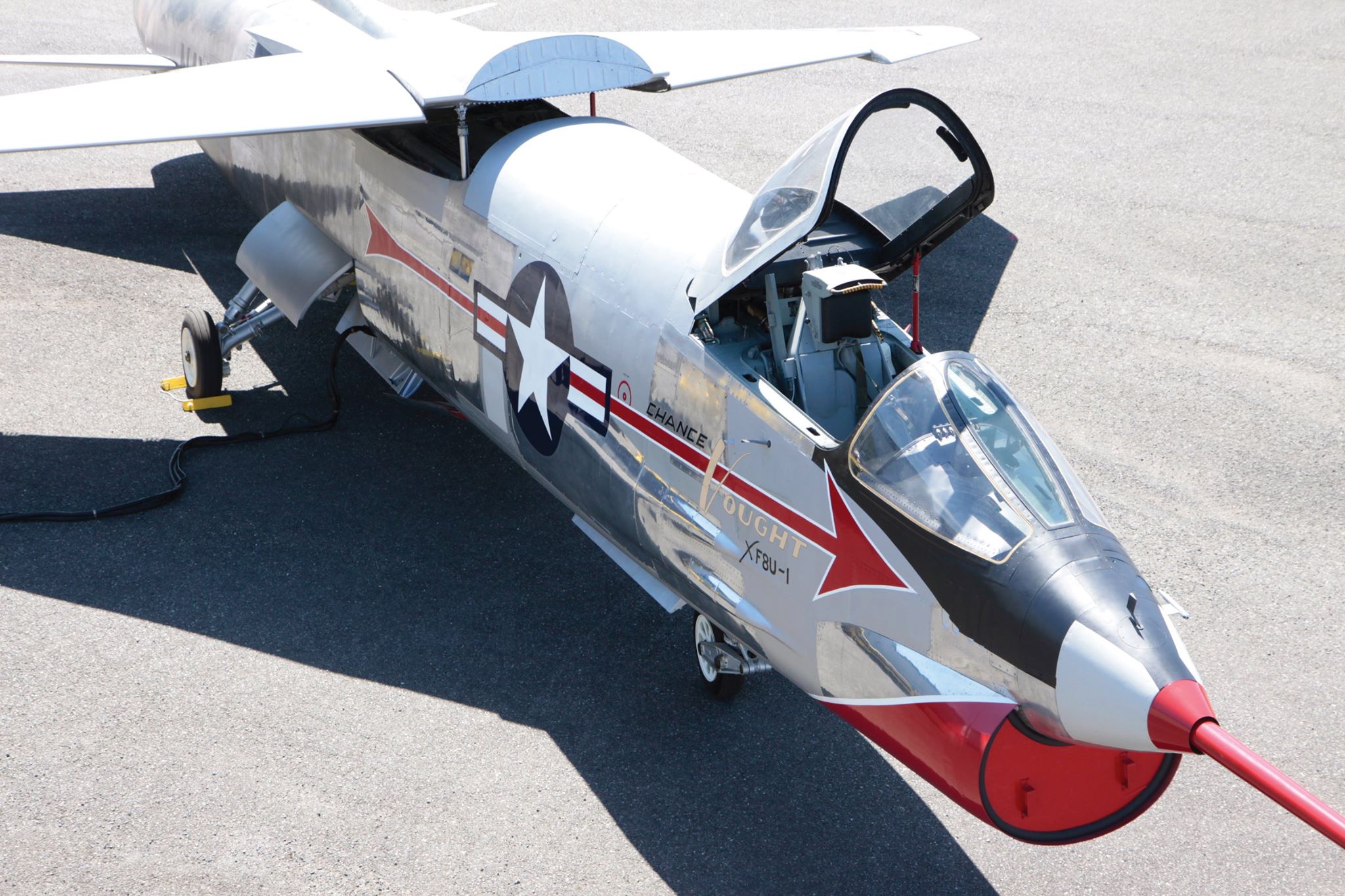
John William Konrad was born 25 November 1923 at San Diego, California. He was the second of three children of William Konrad, a salesman, and Emma Louise Stensrud Konrad.
Konrad became interested in aviation at an early age, learning to fly in a Piper Cub at the age of 15. After graduating from high school, he enlisted as a private in the U.S. Army Air Corps at San Diego, 26 February 1943. Konrad was 5 feet, 3 inches (1.60 meters) tall and weighed 118 pounds (53.5 kilograms). He trained as a pilot and flew Boeing B-17 Flying Fortress heavy bombers with the 305th Bombardment Group (Heavy), stationed at RAF Chelveston, during World War II. He later flew Douglas C-47 Skytrains during the Berlin Airlift.
Konrad married Miss Harriet Marilyn Hastings at Clearwater, Florida, 11 February 1945. They would have two children.
Following the War, Konrad was selected for the first test pilot training class at Wright Field, then was assigned to Muroc Army Airfield (Edwards Air Force Base) in California, where he graduated from the Air Force Experimental Flight Test Pilot School, Class 51-C, 19 May 1952.
Konrad resigned from the Air Force in 1953 and joined the Chance Vought Aircraft Corporation in Dallas, Texas, as a test pilot. In addition the the XF8U-1 Crusader, he also made the first flight of the Ling-Temco-Vought A-7 Corsair II, and the experimental LTV XC-142 tiltwing V/STOL transport in 1964. He was appointed Director Test Operations in 1965. Konrad retired from Vought in 1988 after 25 years with the company.
After retiring, John Konrad continued to fly a Goodyear FG-1D Corsair with Commemorative Air Force.
John William Konrad, Sr., Captain, United States Air Force, died 20 September 2006 at Dallas, Texas. He is buried at the Dallas–Fort Worth National Cemetery.
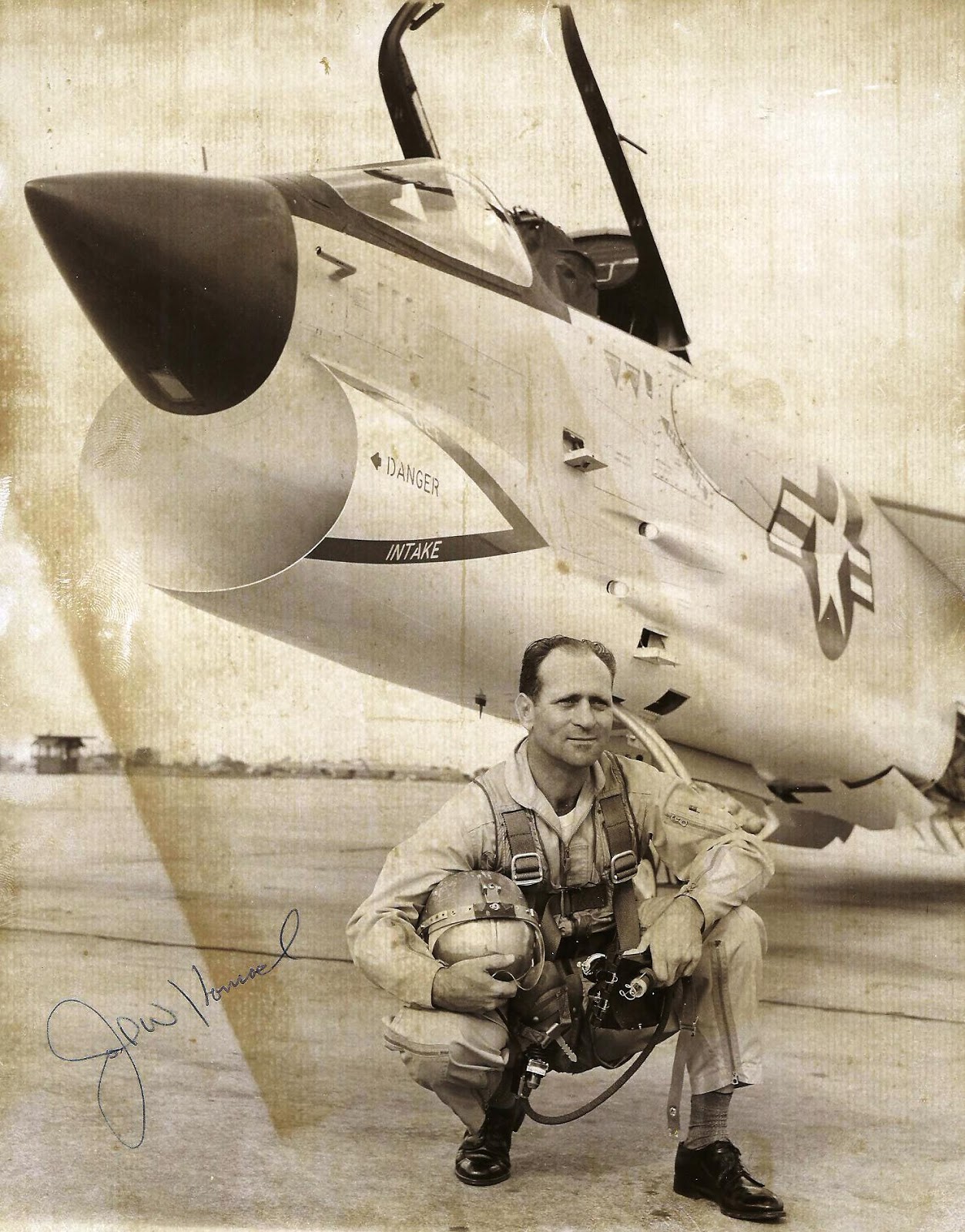
© 2019, Bryan R. Swopes
Bryan – I wanted to take a moment to say Thank You for your coverage of aviation history. As a retired U. S. Navy CPO (1961 – 1981) who served aboard three carriers (USS Essex, USS America and USS Constellation) and a pilot since 1971 your articles always stir memories and fascination…//Loren
Thank you, Loren. I am glad that you enjoy the blog. It’s is wonderful to hear from people who share my interest in history.
Bryan, We recently discovered from Senator, Astronaut and Pilot John Glenn’s Flight Logs that Bu. No. 138899 was probably the first Crusader he flew. His flight log from May 4, 1956 clearly shows he flew our aircraft twice for nearly 2 hours. Of course on July 16, 1957 (operation Bullet) he broke the transcontinental Speed record from LA to NY in 3 hrs, 23 mins in another Crusader. It was said, the Crusader was one of his favorite planes.
We are very proud here at the Museum of Flight in Seattle, to have Bu. No.138899 on display in our Great Gallery. Mike Martinez – Museum of Flight Docent
Thank you, Mike. That is really excellent information. I shall try to incorporate it in my posts. I toured your Museum two years ago and to say I was impressed would be a wild understatement. I wish that I lived closer. . . . I have been unable to verify this, but I believe that the North American Aviation F-86F Sabre on display at NAS Fallon is Senator Glenn’s “MiG Mad Marine” with which he shot down three enemy aircraft during the Korean War. I provided my data to the commanding officer of the air station, requesting a physical verification of the airplane’s data plate. Many many many month’s later, I was informed that the airplane did not have the correct number——based on records, not an actual visual inspection of the airplane. Interestingly, the serial number that the Navy said was the F-86’s was actually that of a Lockheed T-33. I remain hopeful that someday, the MiG Mad Marine will actually be verified and placed in a safe environment, rather than outdoors in the Nevada desert.
Thank you, again, Mike, for your information.
Re: 25 March, F8U Crusader,
The Crusader’s reputation as an “Ensign Killer” was well deserved, later versions were fitted with twin ventral fins toward the rear of the fuselage for improved directional stability at launch, when the pilot could find the sharp end of the aircraft pointed in the wrong direction at low airspeed. I was unable to find the documentation regarding this modification, but I am certain I read about it somewhere.
Thanks, Mike. Apollo mission control flight director Chris Kraft (“Flight”) was the NACA project engineer for the F8U. He discovered dangerous stability problems with the airplane. During high-speed turns,the airframe distorted, causing uncommanded movement in the elevators. He took his concerns to the Navy’s project officer, a certain Marine Corps major (and future astronaut), who was, um, well, less than receptive. Kraft was proven right. The airplane was also suffering compressor stalls, and at high speed and low altitude, the hydraulic system that controlled the wing’s angle of attack wasn’t powerful enough. The wing would pulse up and down. During a demonstration flight at the Chance Vought plant in Texas, a wing tore off. The airplane was destroyed and the test pilot killed. After Kraft had another series of, uh, er. . . “discussions” with Major Gle— I mean, the Navy’s project officer, Kraft and his boss went directly to the CNO’s staff to express their serious concerns. A few days later, the entire F8U fleet was grounded until a fix for the problem was found.
“Because of a high accident rate, the Crusader has also been called “The Ensign Killer.”
To be fair, what high-performance jet fighter from the USN & USAF of that era wasn’t? Even the P-80 had a high number of crashes.
Bryan, thanks for mentioning the F8 on it’s anniversary every year. I have about 1700 accident free hours (well, I did blow one tire) in the F8 in both Vietnam and the reserves at Dallas. I was also fortunate enough to work for LTV and meet John Konrad, Joe Engle, Hoppy New and Bob Rostow at the flight line there. Great guys all.
I believe the original “Ensign Killer” moniker was applied to the F7U Cutlass. I first flew the F8C with ventral fins and found it very stable. But I was a Marine, and maybe that makes a difference – – – – .
🙂
Where is Jim Lovell?
Lovell had just completed flight training and was assigned to fly the McDonnell F2H Banshee. He didn’t graduate from test pilot school until June 1958, long after the first flight of the XF8U-1.
I meant he was born March 25, 1928, https://cs.wikipedia.org/wiki/Jim_Lovell
Oh.